APAH Unit 7: African Art
1/55
Earn XP
Name | Mastery | Learn | Test | Matching | Spaced |
|---|
No study sessions yet.
56 Terms

Warrior Chief and Attendants

Warrior Chief and Attendants (culture & location)
Benin/Edo; Benin, Nigeria

Warrior Chief and Attendants (date & material)
c. 1550-1650 CE; brass

Warrior Chief and Attendants (use & facts)
palace decor
hierarchy of scale (king is largest)
adorned palace in Benin (now in British Museum)
Oba (King) was descendant of original ruler & was deity
Oba controlled trade, art, justice & attendants in plaques symbolize the heavy weights of his job
part of 900 plaques decorating wooden pillars in palace & surrounding courtyard buildings in Benin City
all 900 plaques = continuous narrative & communicated hierarchy of status
made using lost wax process
Oba has symbols of power = leopard, sword, spear
rolls under head = beauty & wealth bc rich enough to be fat
brass from Portuguese traders
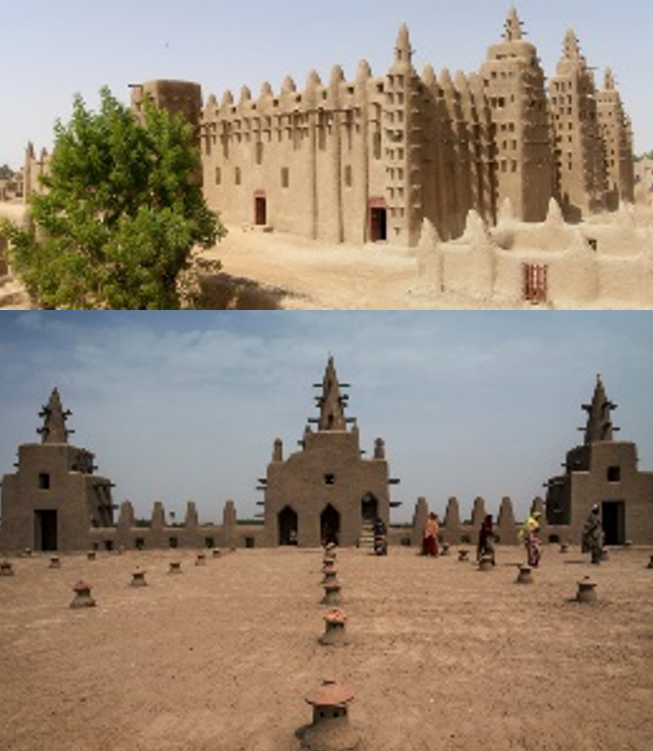
Djenne Mosque (Eastern Facade of Friday Mosque)

Djenne Mosque (culture & location)
Djenne; Djenne, Mali

Djenne Mosque (date & material)
13th century CE & rebuilt 1906-1907 CE; mudbrick

Djenne Mosque (use & facts)
temple
largest mudbrick structure in the world
ostrich eggs on top = ritual purpose/protection & fertility, purity
annual festival of replastering
Djenne was great trading center
Islam introduced in 14th century & mosque built soon after
this is 3rd revision of the building
wood jutting out = torons, climbed on to replaster

Great Zimbabwe (Conical Tower & Circular Wall)

Great Zimbabwe (culture & location)
Great Zimbabwe; Great Zimbabwe, Zimbabwe (West Coast of Africa)
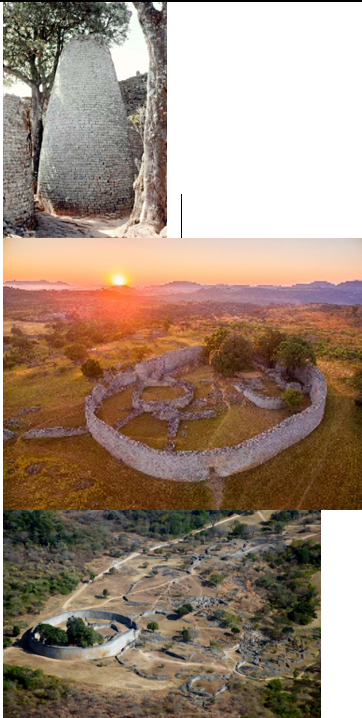
Great Zimbabwe (date & material)
15th century CE; dry stone

Great Zimbabwe (use & facts)
palace, city, & trading center
huge trading city/palace in SW Africa beginning in 600 CE
construction began in 11th century & lasted until 15th century
constructed of dry stone (no mortar)
conical tower = granary?
walls as high as 36ft & held 18,000 people
aka “The Great Enclosure”
largest pre-colonial structure in Sub-Saharan Africa
king lived on hill, enclosure for other royalty, valley for everyone else
ended due to overcrowding, over farming, sanitation issues?
during colonial time, whites thought Africans could not have built this & tried to prove this but failed
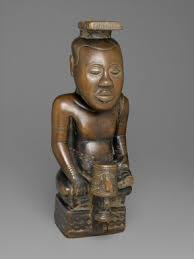
Ndop Portrait of King Mishe miShyaang maMbul

Ndop Portrait of King Mishe miShyaang maMbul (culture & location)
Kuba Kingdom; Democratic Republic of the Congo

Ndop Portrait of King Mishe miShyaang maMbul (date & material)
c. 1760-1780 CE; polished wood (camwood) & powder

Ndop Portrait of King Mishe miShyaang maMbul (use & facts)
represent King of the Kuba Kingdom
rounded contours define head, shoulders, stomach, & collarbone
naturalism but not exact likenesses
expression on face, body position, & regalia represent ideal characteristics of dead king
individual rulers identified by emblem (ibol)
carved & anointed w/ palm oil to protect from insects
cross-legged subjects
1 to 3 proportion of head to body (head biggest)
head emphasized bc it was seat of intelligence (highly valued)
drum w/ severed head is his ibol
polished w/ palm oil to ward away insects & make shiny

Byeri Reliquary Guardian Figure

Byeri Reliquary Guardian Figure (culture & location)
Fang “Nio Biere” People; Gabon
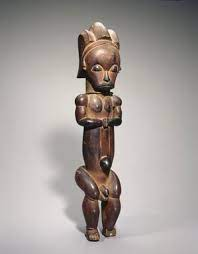
Byeri Reliquary Guardian Figure (date & material)
c. 19th-20th century CE; wood

Byeri Reliquary Guardian Figure (use & facts)
guarded relics
placed on container to guard relics (talisman)
relics are skulls & bones of earlier kings
woman & young people not allowed to look at it
show tranquility, introspection, vitality
abstract body, hair of the time, stylized
rubbed w/ oil to give lustrous finish
also used as puppets in initiation to teach young men about ancestors

Female Pwo Mask

Female Pwo Mask (culture & location)
Chokwe People; Democratic Republic of the Congo

Female Pwo Mask (date & material)
c. 19th & 20th century CE; wood, fiber, & metal

Female Pwo Mask (use & facts)
ritual use for initiation
made & worn by men for initiation ritual w/ costumes including wooden breasts & bustle
woman accept male concept of ideal female, but if they don’t like the performance, they can “chase away” the bad performer
begins with homage to older female ancestors & fertility & later younger women
pwo dance = short steps, sensuous hip movements; mediates tension of separation of boys from moms via sexual movements
young, fertile, successfully given birth

Mblo Portrait Mask

Mblo Portrait Mask (culture & location)
Baule People; Cote d’Ivorie (Ivory Coast)

Mblo Portrait Mask (creator, date, & material)
Owie Himou; c. late 19th century CE; wood, brass, & pigment

Mblo Portrait Mask (use & facts)
portrait for use in public ceremony
part of public ceremony, possibly double of honoree
crowned with horns
high forehead & downcast eyes = wisdom
oval face, elongated nose, small open mouth, downcast slit eyes w/ projecting pieces (animal horns?)
stylistic attributes = visual vocab suggesting what it means to be respected & honorable in Bauble society
scarification
highly polished w/ palm oil
this one is a portrait of a female leader

Bundu Mask

Bundu Mask (culture & location)
Mende People; Sierra Leone

Bundu Mask (creator, date, & material)
Nguabu Master; c. late 19th-early 20th century CE; wood & pigment

Bundu Mask (use & facts)
made for ritual female rite of passage
idealized beauty, small eyes & mouth
mask sits on head, raffia cloaks body
lustrous black color
performed by & for women, made by men
closed mouth, downcast eyes (demur), small ears (don’t listen to gossip), elaborate hair, circles of fat under chin (able to bear children)
scarification around eyes
worn by elders while initiating girls into womanhood

Aka Elephant Mask

Aka Elephant Mask (culture & location)
Bamileke People; Camaroon

Aka Elephant Mask (date & material)
c. 19th century CE; wood, raffia, cloth, & beads

Aka Elephant Mask (use & facts)
worn by royals in court
trunk & ears symbolize strength & power
performace art danced to drum, barefoot
used by high-ranking royals in court
energetic feel

Sika Dwa Kofi (Golden Stool)
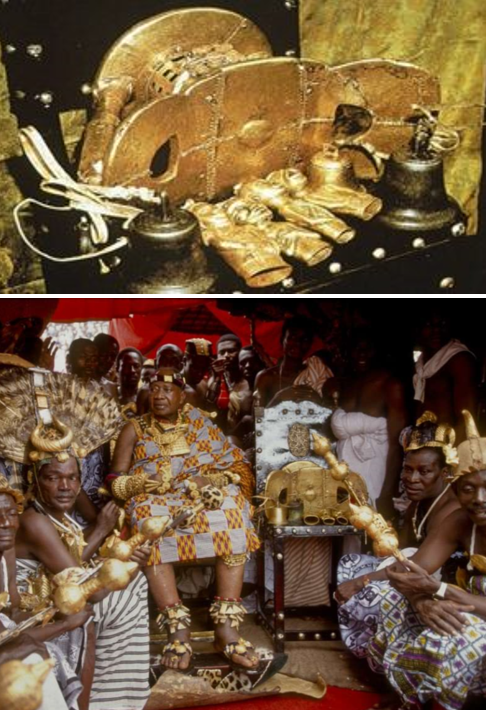
Sika Dwa Kofi (culture & location)
Asante People; Ghana

Sika Dwa Kofi (date & material)
c. 1700 CE; wooden stool covered in gold

Sika Dwa Kofi (use & facts)
symbol of ruler’s (Asantehene) power
said to be dropped from heaven
still exists with Asante people in Ghana
soul of the Ashanti nation, more sacred than the king
always given its own chair & tilted to reserve its use
18 by 24 by 12 in
NEVER allowed to touch the ground & NEVER allowed to be sat on
no one could be considered a legitimate ruler w/ out the golden stool
has its own throne next to the king
used in rituals crowning kings
turned on its side to symbolize no one can sit on it

Nkisi n’kondi (Power Figure)

Nkisi n’kondi (culture & location)
Kongo People; Democratic Republic of the Congo

Nkisi n’kondi (date & material)
c. late 19th century CE; wood & metal

Nkisi n’kondi (use & facts)
magical medicine pouch for a healer
recognizable through an accumulation of pegs, blades, nails or other sharp objects inserted into its surface
fetishes = protective figures used by individuals or communities to destroy or weaken evil spirits, cure illness, & repel bad deeds
statue activated by holy person using magical substance
nkisi = a spirit, the medicine used by the healer
medicinal combinations called bilongo are stored in the head or belly of the figure, shaded by a piece of glass or reflective surface (represents other world inhabited by spirits of the dead to see enemies)
nails hammered in used to call spirit to do its bidding
moyoo = belly, spiritual center of nkisi where medicine was placed
used by ritual specialists called ngangas
nganga remember what each nail was for, no written history

Lukasa Memory Board

Lukasa Memory Board (culture & location)
Mbudy Society, Luba People; Democratic Republic of the Congo

Lukasa Memory Board (date & material)
c. 19th century CE; wood, beads, & metal

Lukasa Memory Board (use & facts)
recorded important information & oral tradition
used to record important information
each board is unique
only senior members can interpret these boards
history is dynamic & interpreted
serves as mnemonic device
small enough to hold in the left hand & read w/ right forefinger
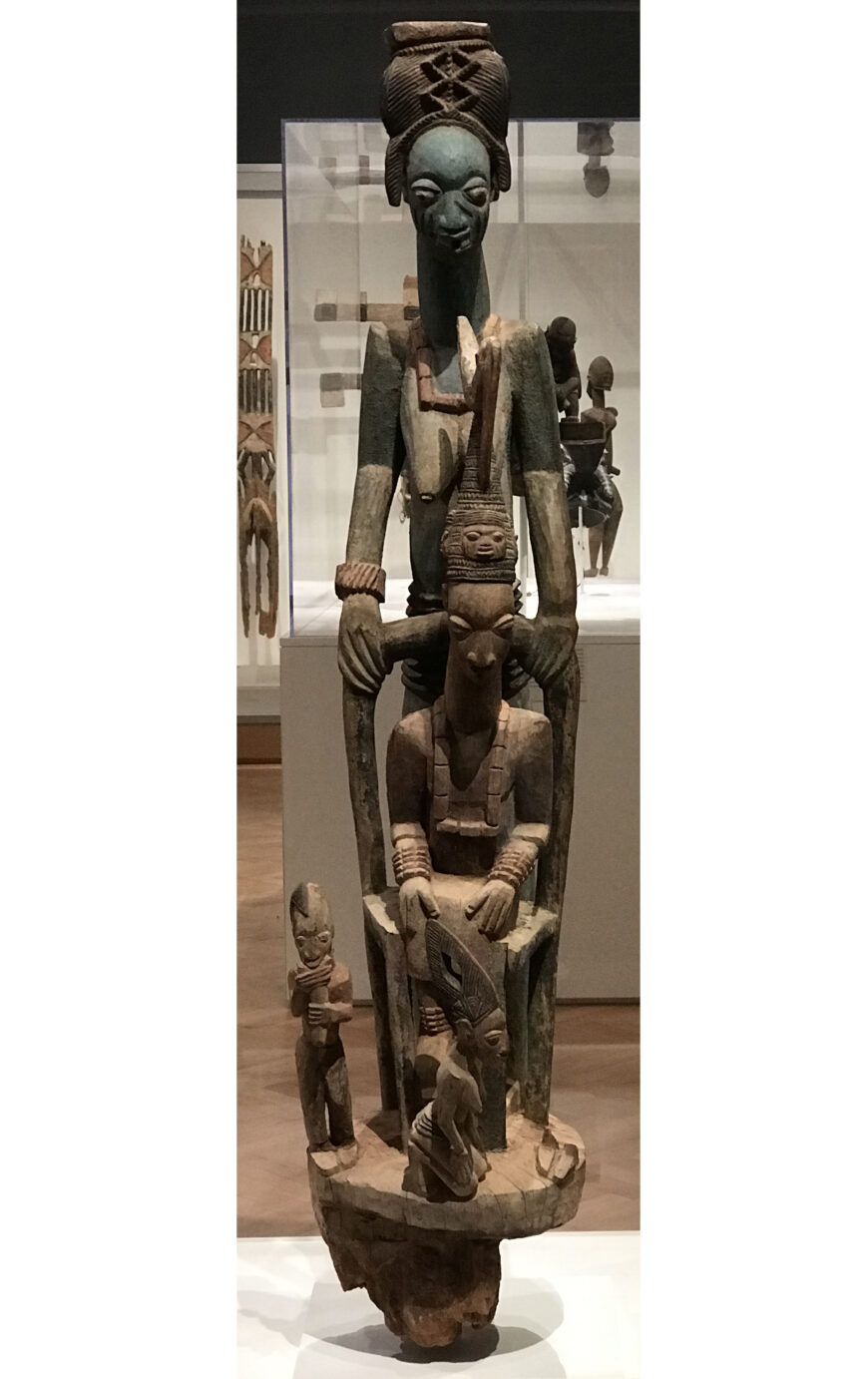
Veranda Post of Enthroned King & Senior Wife

Veranda Post of Enthroned King & Senior Wife (culture & location)
Yoruba People; Nigeria

Veranda Post of Enthroned King & Senior Wife (creator, date, & material)
Olowe of Ise; c. early 20th century CE; wood & pigment

Veranda Post of Enthroned King & Senior Wife (use & facts)
supported roofs of courtyard verandas in royal palaces
vertical, columnar nature of this sculpture typical of the use, veranda post to support roofs of courtyard palace
larger than life sculpture of a royal family
elongated heads & breasts form diagonal lines
negative space enables figures to be seen fully in the round
artist carved posts for rulers of Yoruba kingdom in Nigeria
king in focus but large-scale wife supports the throne (she is bigger bc her job to protect him & crown him)

Ikenga Shrine Figure

Ikenga Figure (culture & location)
Igbo People; Nigeria

Ikenga Figure (date & material)
c. 19th cenutry CE; wood

Ikenga Figure (use & facts)
figure for use in personal shrine for Igbo and/or Benen People
ikenga = power of the right hand (control)
horns symbolize thinking & fighting w/ their heads
human face w/ animal attributes
size variation
sit on ceremonial stool w/ sword in right hand (expression of power)
head in left hand symbolizes warrior status
personal objects relating to status in society
scarification on temple & horns
activated by prayer & sacrifice
one of the most powerful symbols of Igbo people, mainly maintained & owned yb men but occasionally a woman
combines person’s chi (personal god/ancestors) ikenga (right hand), & ike (power)